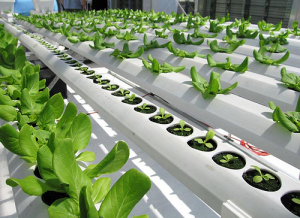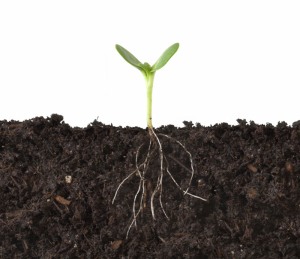Hydroponics V. Soil
 Hydroponically-grown. Soil-grown. Ever wonder what’s the difference? Hydroponic enthusiasts swear by their technology, and soil proponents swear by theirs. But which is better? Is one healthier than the other? And what about environmental impacts? Is one ‘greener’?
Hydroponically-grown. Soil-grown. Ever wonder what’s the difference? Hydroponic enthusiasts swear by their technology, and soil proponents swear by theirs. But which is better? Is one healthier than the other? And what about environmental impacts? Is one ‘greener’?
In hydroponics, water replaces soil as the medium by which plants derive nutrition. A hydroponic system can be as simple as growing in a mason jar or bucket—what’s known as ‘static solution’— or as complicated as continuously misting or ‘aerosoling’ plant roots—Aeroponics. There’s also Continuous-Flow, (water cycled continuously past the roots); Passive Sub-Irrigation, (plants grown in a porous, inert medium); and Rotary (plants rotated slowly on a circular frame to expedite root growth). In each, a nutrient solution is added to the water to ensure health and vitality.
Hydroponics boasts some tremendous advantages. An efficient system uses just 1/20th the water that traditional farming does. Nutrient levels can be precisely controlled, ensuring better yields. Additionally, hydroponics can be employed in environments where traditional agricultural practices would be impractical. And let’s be honest: growing stuff in water is just plain cool.
Still, hydroponics is far from perfect. Hydroponic systems, unlike soil, are susceptible to technical failures, leading to rapid, widespread plant death. High moisture levels can spur pathogen attacks such as damp-off. And hydroponic systems, due to their complexity, are often more energy- and resource-intensive than their traditional soil-grown counterparts. What’s more, hydroponically grown produce cannot qualify for organic certification; this is because the growing medium is inorganic.
 In traditional soil-based agriculture, plants derive nutrition via mineral deposits within the soil base; the healthier, more biologically diverse the soil, the healthier, more disease-resistant the plant. A truly sustainable, closed-circuit organic farm requires no additional inputs (supplements, aeration mechanisms, lightening systems), making it the ‘greenest’ method. And of course organic soil-farming has benefits ranging beyond watersheds and consumers: the entire biome is benefited, from the tiniest bacteria to the largest mammal. Hydroponics, always operating at a remove from the natural cycle, has a limited impact on the surrounding environment.
In traditional soil-based agriculture, plants derive nutrition via mineral deposits within the soil base; the healthier, more biologically diverse the soil, the healthier, more disease-resistant the plant. A truly sustainable, closed-circuit organic farm requires no additional inputs (supplements, aeration mechanisms, lightening systems), making it the ‘greenest’ method. And of course organic soil-farming has benefits ranging beyond watersheds and consumers: the entire biome is benefited, from the tiniest bacteria to the largest mammal. Hydroponics, always operating at a remove from the natural cycle, has a limited impact on the surrounding environment.
In terms of nutrition, hydroponic proponents claim theirs is the superior product, but so far there are no conclusive, scientific studies to back this up. While quality in either method is largely a factor of the growing medium, only soil-grown has the advantage of being more readily able to mediate excess nutrients. Hydroponics, as mentioned above, requires an additive solution; unless that solution is absolutely precise, the nutritional content can suffer. The same is not true with soil-grown.
In the end, whether hydroponic or soil-grown, what matters most is quality. A caring and discerning hydroponic farmer is sure to produce nutritious and delicious fruits and vegetables just as readily as a caring and discerning organic farmer. A win-win situation for a caring and discerning consumer!
